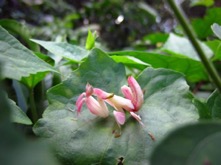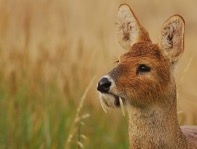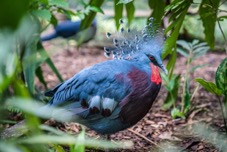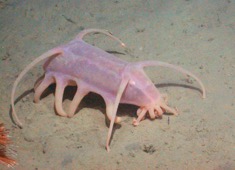|
April Abloom
Marin Park Stewardship April 2018 Newsletter
|
Dear Friend,
Is it just us, or has the number of
rainbow sightings skyrocketed in the past month? And have you seen the
wildflowers? We’ve been thrilled with the beauty of April so far, and equally
grateful for the increase in precipitation our park has seen.
We also were not disappointed by the opportunity
to let out our inner tricksters (April Fool’s Day, anyone?), and that is
reflected, for better or worse, in our newsletter this month. First, there are
some plants that may look inviting…but whatever you do, don’t eat them! Second,
we have a rather bizarre animal lineup…can you spot the trick here?
In This Newsletter
Perilous Plants That Poison
By Maria Pezza
There are plenty of plants you should be careful around. The
first one that comes to mind, especially for those of us who spend time working
in close quarters with plants, is poison oak. Get too friendly with any part of
this plant, and you might spend several itchy weeks regretting it.
Another plant that causes instant discomfort—and there have
been intense debates over which of these two is less pleasant—is stinging
nettle.
Here are three more plants to add to your “caution” list.
While you can touch and smell them without dire consequences, you most
certainly shouldn’t do anything more. All the plants can be found in Marin, so
keep your eyes open!
Death Camas
Toxicoscordion
venenosum
I sincerely hope I don’t have to tell you twice to stay away
from any plant whose name has “death” in it, but I suppose it’s worth saying:
don’t eat this one.
While you would have to consume a large amount of plant
material for it to result in death, humans have been poisoned after eating
death camas. Every bit of this plant is toxic to humans, from the bulbs in the
ground, which have been mistaken for onions, all the way up to the flowers,
which are deceptively pretty and can be tempting to children and animals alike
Poison Hemlock
Conium maculatum
This plant belongs to the same family as the carrot—a familiar
plant that many of us use and enjoy—but its name should tell you all you need
to know about how friendly this plant is. While the seeds of the plant have the
highest toxicity, consumption of any part of the plant could mean death to
mammals.
The most famous case of
this is, of course, the use of poison hemlock in the execution of Socrates in
399 BC, but modern-day humans have been known to mistake the roots of the plant
for wild carrot or parsnip—with tragic results. Gatherers beware!
Toyon
Heteromeles
arbutifolia
Some of you may balk at this tree being included on a
“poisonous plants” list, but don’t stop reading just yet! Perhaps you’ve heard
mention of its possible use in medicine, or maybe you know that original
inhabitants of California used the berries as a food source. A 2016 study
examined the traditional use of the berries as a treatment for Alzheimer’s
disease, and found that, while not exactly a cure, certain doses of the berries
might slow “the progression of the disease and helps patients continue to have
productive lives.”
The leaves, however, have been reported to contain cyanide,
a common component of plants in this family (Rosaceae). There seem to be no
reports of human deaths from eating the leaves of toyon, but the California
Poison Control System does list the plant’s leaves as having major
toxicity—ingestion of this plant could cause major systems (think heart and
brain) to fail.
There are many edible plants in and around Marin county;
just be sure to do your research!
Sources
Death
camas: http://www.cbif.gc.ca/eng/species-bank/canadian-poisonous-plants-information-system/all-plants-common-name/death-camas/?id=1370403267102; https://commons.wikimedia.org/wiki/File:Death_camas_Zygadenus_venenosus_3_(18466934961).jpg
(photo)
Poison
hemlock: https://www.invasive.org/browse/subinfo.cfm?sub=4365; https://gobotany.newenglandwild.org/species/conium/maculatum/; https://commons.wikimedia.org/wiki/File:Conium_maculatum_2.jpg
(photo)
Toyon: https://www.ncbi.nlm.nih.gov/pmc/articles/PMC5456246/; https://calpoison.org/topics/plant#rating; https://www.flickr.com/photos/rezlab/5386844434
(photo)
Frightening Fauna Tha Might Fool You
By Ailsa Harju
In the spirit of April Fool’s Day, I have included short
biographies of four animals. Three exist in the wild, but the fourth is fake!
Can you decide correctly which one is false?
Malaysian orchid
mantis
Imagine that, on a tropical island hike, you watch a
beautiful butterfly land on an equally beautiful flower. The butterfly steps
forward, extends its proboscis and in a violent move, the flower petals engulf
the butterfly whole.
The culprit is the female Malaysian orchid mantis, which has
developed a unique and efficient mimicry technique over time, leading to strong
predatory success; to insects, they are indistinguishable from flowers. Though
there is no particular orchid that the mantis resembles, it is gorgeously
colored pink or yellow and displays vibrantly on green vegetation, waiting for
pollinators to prey on. The display is so convincing that the mantis has been
shown to attract pollinators at even higher rates than actual flowers.

Chinese water deer
The Chinese water deer has a fiendish head, with long
canines protruding well-outside of the mouth, resembling vampire fangs. The
deer has no formal antlers, instead sporting small devilish spikes atop the
head.
Despite these spooky features, the water deer is, frankly,
adorable. They are small, rising only half a meter above the ground, and their
cute, rounded ears lead to frequent comparisons to stuffed bears. They do not
drink blood either, and opt for grasses and sedges instead.
These deer are native to coastal plains, salt marshes, and
riparian zones of China and Korea. There they live a solitary life, outside of
mating season. They are IUCN Red List-labeled as “threatened.”

Ruby-wattled pigeon
Throughout southern Africa, the male ruby-wattled pigeon can
be found hopping high from the forest floor in his exhausting mating rituals.
This ability to hop several feet in the air easily compensates for the species’
poor flying abilities, and they stick to eating seeds and berries of low-hanging
trees and shrubs.
Once paired with a female, the couple will lay one egg at a
time in grounded nests. These locations, though well-hidden in the underlying
vegetation, are highly susceptible to predators, like the many poisonous snakes
of the region.
To protect their chicks, ruby-wattled pigeons
are fiercely defensive, and they have one trick up their wing: when stressed,
the pigeon secretes a liquid toxin in its wattle, which it sprays at would-be
offenders.

Sea pig
Sea pigs are actually sea cucumbers that often appear plump
and pink, like a pig. They scavenge the sea floor in the deepest and darkest of
oceans for bits of decaying material and carcasses.
On large, nutrient-rich whale carcasses you can find
hundreds and even thousands of sea pigs furiously feeding, all facing the same direction. Though this is an eerie sight to
stumble upon, sea pigs face in the direction of the current so that they can
smell and/or grab food coming their way.
Sea pigs’ legs are fluid-filled appendages,
rather than formal structures, and can be inflated or deflated at will. Like
all echinoderms, they have tube-feet, which allow them to walk (slowly) by
hydraulic pressure.

Sources:
http://www.jstor.org/stable/pdf/10.1086/673858.pdf?_=1460562037940
http://www.iucnredlist.org/details/10329/0
http://eol.org/pages/599675/details#morphology
Image Sources:
https://news.nationalgeographic.com/2016/12/orchid-mantises-evolution-insects/
https://www.wired.com/2014/06/the-creature-feature-10-fun-facts-about-sea-pigs/#slide-1
https://haydensanimalfacts.com/2014/11/08/5-interesting-facts-about-chinese-water-deer/ https://billandpaige.com/victoria-crowned-pigeon-nature-park-port-moresby-png/
Answer:
The
false animal is the ‘ruby-wattled pigeon.’ The featured photo is of a
Victoria-crowned pigeon, with a turkey wattle photoshopped on top!
|
An Update on
the Fish
As some of you may know, we closely monitor many species of
fish we have in our parks. This is both to determine the health of our creek
ecosystems, and to better protect threatened and endangered species. Earlier
this year, we talked about an exciting release of almost 200 California coho
salmon into Redwood Creek. For an update on the results of this experiment, and
for general information about how our fish are doing these days, check out this National Park Service article.
Earth Day
Celebration at Stinson Beach
Want to come celebrate the earth with us?
Earth Day 2018 will fall on Sunday, April 22nd,
and our partners at One Tam will be hosting an event at Stinson Beach to celebrate!
Come clean up the beach, do some creek restoration, have a picnic, and join
artists in creating works of ephemeral art on the beach. You can find all the
details at www.earthdaystinsonbeach.org.
We hope to get the chance to celebrate with you!
Marin Volunteer Program Information and Work Day Schedules
Marin Park Stewardship
Saturdays, 10 am–1 pm, and Wednesdays, 1–4 pm
We alternate between sites, so check the details for each work
day. Work day events include a combination of hands-on service and short
natural or cultural history lessons.
Click here to learn more
or sign up.
Wednesday Programs
April 4: Wolfback Ridge
April: 11: Oakwood Valley
April 18: Wolfback Ridge
April 25: Oakwood Valley
May 2: Wolfback Ridge
May 9: Muir Beach
May 16: Wolfback Ridge
May 23: Muir Beach
May 30: No program
June 6: Oakwood Valley
June 13: Muir Beach
June 20: Wolfback Ridge
June 27: Muir Beach
Saturday Programs
April 7: Oakwood Valley
April 14: Muir Beach
April 21: Earth Day event, Oakwood
Valley
April 28: Oakwood Valley
May 5: Oakwood Valley
May 12: Muir Beach
May 19: Wolfback Ridge
May 26: No program
June 2: Oakwood Valley
June 9: Muir Beach
June 16: Wolfback Ridge
June 23: Muir Beach
Meeting Locations and Directions
Muir Beach – Meet at the parking lot picnic
tables. Map
Alta Avenue at Oakwood Valley – Meet at the park gate located
at the end of Donahue Street. Map
Wolfback Ridge – Take a right on Bunker Road
(immediately before the tunnel). Park in the lot by the bus shelter behind the
Marin Headlands sign, only in a designated parking spot (not along the road).
We will meet in the parking lot. Map
Marin Headlands Nursery
Wednesdays, 1–4 pm
1st and 3rd Tuesday of every month, 10 am–2 pm
Come grow with us at the Marin Headlands Nursery! Each year, we
grow over 30,000 plants to restore natural habitats within the Marin Headlands.
The dedication and support of our volunteers are vital in the effort to grow
plants, collect seeds, maintain the nursery facility, and much more. Our
projects are outdoors, fun, and always hands-on.
For program updates
and registration, click here.
Habitat Restoration Team
2nd and 4th Tuesdays, 10 am–2 pm
Sundays at 9:30 am–2:30 pm
Help restore and monitor critical natural areas from the Marin
Headlands to Bolinas Ridge. Volunteers and staff meet at different scenic
locations each week to restore native habitat throughout the Golden Gate
National Parks. Come out and explore beautiful areas while assisting in
invasive plant removal, winter planting, and seed collection. For more
information, click here.
Invasive Plant Patrol
Wednesdays, 10 am–2:30 pm
An ounce of
prevention is worth a pound of cure. Invasive Plant Patrol volunteers hike
throughout the Marin Headlands to find new invasions of exotics and remove
localized infestations before they get out of control. Get to know the park
trail systems and learn to identify plants, both native and invasive. Hikes
will last approximately four hours. Locations vary from the Marin Headlands to
Bolinas Ridge. For locations and to register, click here.
Thank you for supporting the Golden Gate National Parks Conservancy!
- Marin Park Stewardship

|